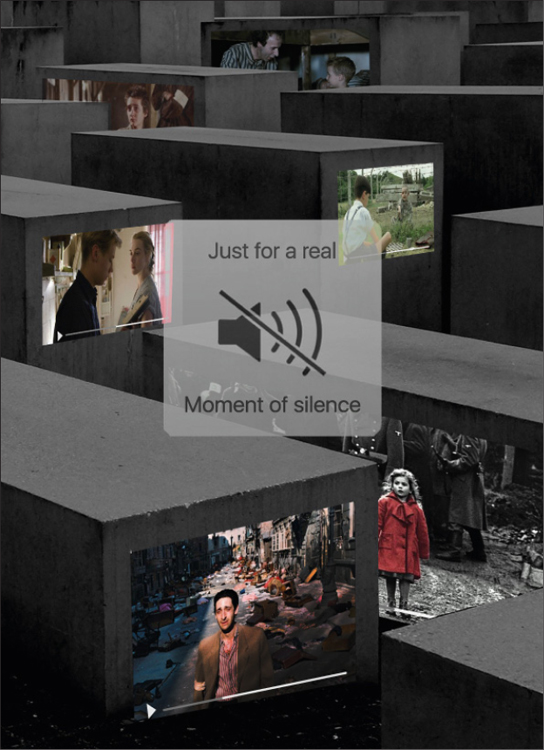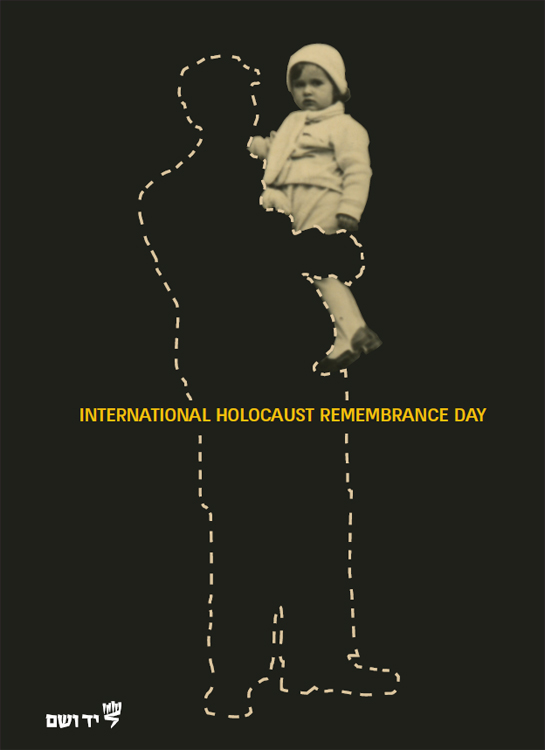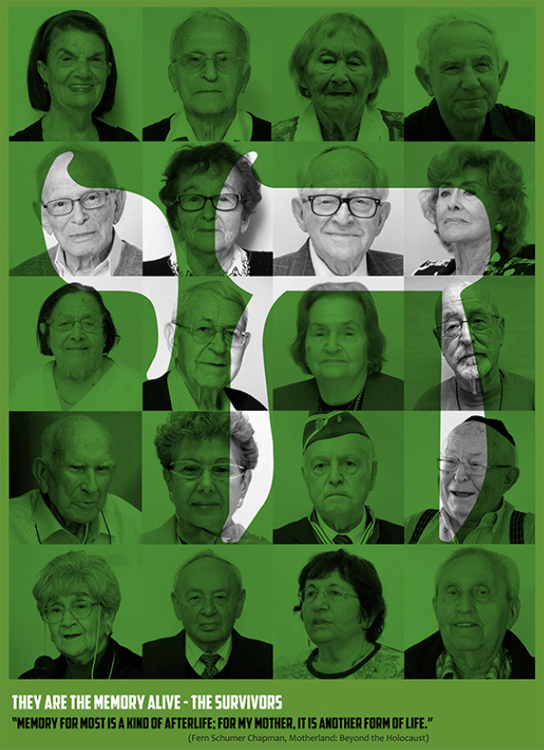Ages: 15+
What is the Purpose of Memory?
This lesson attempts to address this question looking at the 3 winning posters.
3rd Place: Adelina Shaydullina, Russia

Adelina Shaydullina, Russia
This poster depicts recognizable visual images of films and TV shows about the Holocaust, projected onto the stones of a famous Holocaust memorial. Laid over it is the “Mute” signal, which is even more recognizable than the images and the monument.
Why does the artist believe that we need a moment of silence, what are we trying to listen to? How much are we able to listen to what the stories are, or how much do we need the media to shape our recollection of history? What we hear instead of muted silence are the voices of the movies and dramatic adaptations of the Holocaust. The poster has projected images onto a famous monument- are we able to take a moment to be silent and remember, or are our memories influenced by the dramatic reconstructions of what we have seen? Are we able to reflect, in a "real moment of silence", as to what we can see beneath the surface of the films? Does the mute enable us to listen to the voices and process them? Or is our silence crowded by our associations with popular culture? How are images and photographs responsible for what we remember?
Discussion Questions:
- What do you think the artist means in using the “mute” symbol? Why does the artist feel the need to add the videos to the backdrop of the monumentIs there such a thing as real silence? What purpose does it serve?
- To what extent does an image- still or moving- replace the voice of the survivors?
- What are the dangers of using images that aren’t authentic records of the Holocaust to learn about it?
- What is the role of film and TV in shaping our memories?
See the previous collections of posters.
What is the challenge of memory in our time? Can you identify other posters which are dealing with similar challenges? What answer did they provide to this challenge?
Additional Resource for Teachers:
2nd Place: Yael Boverman, Israel

Yael Boverman, Israel
On this poster, we see a natural pose - an adult hugging a toddler - a sign of protection. We see very clearly in the poster that the adult has disappeared from the picture, has been cut out, as the natural order of the world has been turned on its head. The world of the child is incomplete, it will never be the same again. In this way, society’s shared responsibility is very clear from this poster - that we must strive to ensure that no more children experience this upside-down state of affairs, that the natural world order is restored and parents can protect and care for their children. To uphold the written treaty between parent and child.
In Holocaust history, we rescue the individual out of the piles of bodies, and this way we can learn the human story. This is the only way that memories can be restored. The artist is the daughter of the toddler pictured on the poster. By using her mother’s image, and depicting the fate of her grandparent, she makes a very strong and evocative statement about passing memory down the generations.
Discussion Questions:
VIEW: Page of Testimony about MENDEL EBENHOLZ. This is the person (the artist's grandfather) who features in the design. What can we learn about him from the information that was submitted?
- Why has the artist chosen to delete this person in the picture? What does that tell us?
- What is the message that the artist is trying to pass on?
- What are the challenges of memory and commemoration that are introduced in this poster?
“Remember only that I was innocent and, just like you, mortal on that day, I, too, had had a face marked by rage, by pity and joy, quite simply, a human face!”
Jewish Romanian Poet Benjamin Fondane, deported from Paris to Auschwitz-Birkenau in 1944, where he perished.
- The deleted person in this poster- the grandparent of the artist- also bore a human face. What is our responsibility in seeking out the history of the person whose face we can no longer see, and what meaning does it bear?
- How do you think that a child's survival, alone, would influence their identity?
Additional Resource for Teachers:
- Online Exhibition: I Am My Brother's Keeper: Righteous Among The Nations in the Holocaust
1st Place: Julia Brancagliogne Cristofi, Brazil

Julia Brancaglione Cristofi, Brazil
This is a montage of Holocaust Survivors, with the Hebrew word חי- - Life- creating light in the shadows. We see the Survivors faces emerging out of the dark into the light of the word life. Many of them are smiling. We see that they appear fulfilled. So many survivors see it as their prime responsibility to keep living in order to continue to share their dreadful experiences, despite the unbelievable situations that they endured during the Holocaust. These dark times are symbolized in the shadows in the design. So many have dedicated their lives to benefiting their communities and contributing to society.
While the past and the present are strong themes within the design, so is the future - as we are to understand that they continue to honour their responsibility of keeping memory alive. Holocaust survivors, in the main, built themselves new lives after the Shoah – they had families, they studied, they worked, and they lived. The poster demands that we acknowledge what they have carried with them on their life's journey after the catastrophic loss brought about by the Holocaust. We must acknowledge where they have come from, and what was taken from them, and look at them again, from a new perspective. Every joyous occasion, every development and every achievement of Holocaust survivors seen through this lens is far more complex. And with that, the race against time: 10 years ago there were far more faces to fill this montage. Most of the people who will look at this poster as it is displayed across the world will never meet a Holocaust survivor. They are also even more likely to meet someone who will tell them that the Holocaust never happened. How are we supposed to respond to this reality?
Watch:
Six of the featured faces in the poster lit torches at Yad Vashem's Annual Holocaust Remembrance Ceremony in 2017. Here, they share their testimony in short subtitled films:
Questions for Discussion:
- What is your first impression on looking at this poster? Each survivor has a very different and unique story, which is not reflected in the poster. What is the artist trying to pass on by placing these unique individuals and stories together in a group Why did the artist choose the word life, and why did she choose to write it in Hebrew?
- Does knowing more about some of the individuals on the poster create a stronger connection with them than with the other faces, whose names you don’t know?
- Looking at the faces, you would not know that they had survived the Holocaust. What were the challenges that they needed to face in order to rebuild their lives? How does this connect with the artist's choice to use the word "life"?
Additional Resources for Teachers:






